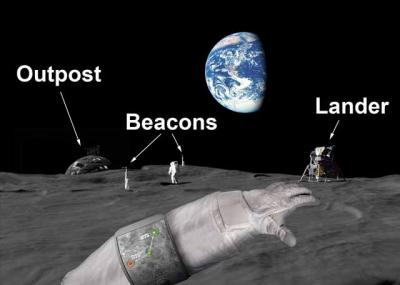
The Crazy Lune

 |
The Crazy Lune |
 |
|---|
      |
|
Astronaut RFID Link Radio frequency identification (RFID) is a method of remotely storing and retrieving data using small devices called RFID tags which in our case are embedded into the bread crumbs. We took reference from a paper on "Zero-Collision RFID Identification using CDMA" (Zero-Collision RFID Tags Identification based on CDMA,(Wuu, L.C. and Chen, Y.J. and Hung, C.H. and Kuo, W.C. at 2009 Fifth International Conference on Information Assurance and Security) for using CDMA modulation scheme for the communication link between the astronaut and the RFID tags. The paper proposes a scheme of zero-collision RFID tags identification for bulk reading of tags. We apply the CDMA technology along with the concept of hash-chain to provide a zero-collision and secure channel between the astronaut and the tags. In summary, the proposed scheme has the following properties: |
|
1. Zero-collision tags identification: Reader can know the identities of several tags (crumbs) at a time by allowing those tags to send a hello signal simultaneously. 2. Mutual authentication: During the identifying process, both the reader and tags can mutually authenticate each other. 3. Tag anonymity: Attackers cannot infer any tag identity from the messages exchanged by the reader and the tags (Intruders beware!). 4. Robustness: Tags are not required to be available for each identifying process. 5. Forward secrecy: Attackers cannot infer the new key by any old key (using Hash Chain technology).
Code Division Multiple Access (CDMA) CDMA signals are encoded such that information from an individual tag can be recovered by a the astronaut which knows the code being used, in the presence of all other CDMA signals in the same bandwidth. To do that, each tag is assigned a different code from a set of orthogonal codes, and then the tag uses the assigned code to modulate the transmitted data. The Astronaut (receiver) decodes the signal sum by taking a dot product of the received signal and the assigned code of a transmitter (RFID tag). The CDMA codes are typically 16 bits to many thousands of bits in length, and the bits are called chips. The CDMA chip sequence modulates the data bits of the original message.The chip rate is much greater than the data rate which greatly increases the speed of digital transmission, widening the spectrum hence the name Spread Spectrum. We use the Gold Code sequences to assign independent codes to each tag. A Gold code, also known as Gold sequence, is a type of binary sequence, used in CDMA and satellite navigation (GPS). A set of Gold code sequences consists of 2m + 1 sequences each one with a period of 2m − 1,where 'm' is the number of chips (20480 for gold code). Within a set of Gold codes about half of the codes are balanced i.e. the number of ones and zeros differs by only one.
|
Home | Project | Communication | Location | Power | Budget & Timeline Tuesday, December 8, 2009 © 2009 The Crazy Lune. All rights reserved. |